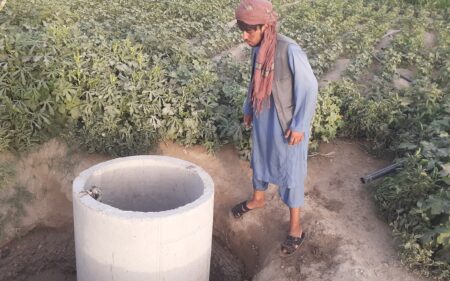According to them, every deep well that used to give four inches of water now gives only one inch of water. Each well is 45 to 120 meters deep.
The farmers say that if the water supply issue is not solved by the government, the area will face a great human disaster due to the shortage of potable and agricultural water which will lead to displacement inside the house.
On the other hand, there are no accurate figures and numbers in Helmand that how many people have dug deep wells and how many cubic meters of groundwater are used in the fields every day, and how much fresh drinking water decreased.
But in every ten acres of land, there is a deep well in the fields, which irrigates the agricultural and desert lands.

Mohammad Ewaz, a resident of the Tarikh Nawor area, planted corn on his land this year, ironically saying that he is facing a shortage of water and the deep wells are not giving as much water as before.
At the same time, he fears that if the drought continues, and farmers have limited access to river water, people will not have enough drinking water in the future.
“One well over ten acres of land is OK. The water has receded to a certain extent, but the rains have reduced it to a certain extent, but after the rains subsided, the water receded again.
This farmer says that in the past, water used to come out at 20 meters, but now they dig a well at 120 meters and without water, they cannot get enough water for irrigating the land.
The situation is the same in the Nava district of Helmand. Here we see a farmer who irrigates his land with a water pump and draws water from a well about 120 meters deep. This man’s name is Mirajan and he has the same complaint as Mohammad Ewaz, he says that this year the water is not tasty and has decreased a lot.
He told Killid Radio: “Farmers are in a bad situation. This year, they did not plant autumn crops, there is no water. The rain is not enough. Water from deep wells has also been drained. The government should help farmers and agriculturists.”
Apart from Nawa, we also visited Nawzad district. Here we meet a farmer and gardener named Ghawsullah Tawheed. Here the reservoir water has dried up and drinking water is not available.
Tawheed says that hundreds of acres of gardens have dried up due to the drought and people have moved to other areas due to bad weather.
According to him, the main reason for people’s immigration is that even water for drinking and washing dishes is hard to find.
He says: “There were gardens in it. Like pomegranates, almonds, and other fruits, due to the recent droughts, the grounds dried up and the gardens also dried up, people moved to other places, the most of our villages rely on animals to bring water from far away areas.

Experts have also worried about the ongoing drought, groundwater depletion, and the lack of water in rivers.
They say that the lack of groundwater is not only rooted in low rainfall but also the indiscriminate and inappropriate use of water and the conversion of old deserts to agricultural lands by the people and then watering them with wells has caused this problem.
Agriculture expert engineer Habib Rahman Wakmal is of the same belief. He says that hundreds of thousands of hectares of desert land have been converted into agricultural land.
He added to the Key Radio: “There was less rain last year, and the whole desert has been occupied by people and all agriculture is done by groundwater.”
Officials of the water management office in Helmand also believe that the unprofessional and arbitrary digging of deep wells, lack of rainfall and ground or surface water, and improper water management have increased the risk of water shortage.
According to Abdulwahid Saadat, Manager of the Helmand Water Management Office, many wells in some northern districts of Helmand have been emptied of water, and filling and digging them is not an easy task and requires a lot of effort and investment.
“Unfortunately, it has recently been seen that deep wells are being dug in the districts in an unprofessional manner and the water is being used excessively, giving the negative impression that all the reservoirs of some northern districts have completely dried up.”
In spite of all these problems, in the year 2017 Afghanistan Research and Evaluation Foundation claimed in a report that if groundwater is used for agriculture in Helmand in a continuous and fearless manner and if it is not prevented, Helmand may not have any water for the next ten years.
Translated by: Shir Ali Jafari
Follow TKG on Twitter & Facebook











